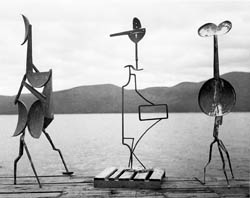What’s the difference between “The Birth of Venus” and “David”? The answer seems obvious: one is a painting, the other a sculpture. But to abstract expressionist David Smith, the difference between the two art forms was not so vast. He sees them as separated by just one, easily adjustable distinction: dimension.
The manipulation of that difference is the premise of David Smith Invents, a new exhibition open in DuPont Circle’s Phillips Collection through May 15. The exhibit features works of varying media—from clay to canvas to steel—which display Smith’s blurring of the line between two dimensions and three.
On first look, the majority of pieces seem to fit obviously into one category or the other. The exhibit’s first room is almost exclusively canvas paintings, including the large “Untitled” (1959), a spray-painted piece featuring Smith’s signature abstract white shapes on a fading black background. After a closer look, however, the seemingly dichromatic painting is actually layered with varying shades of white and speckled with flecks of blue and green, which add a figurative dimension to the flat painting.

On the three-dimensional end, this same room contains one single sculpture standing on a pedestal in the middle of the room—“Tanktotem IV,” a steel conglomerate of half-circles which stands on two leg-like poles jutting out from the bottom. This piece becomes far more impressive in a black-and-white photograph on the wall next to it, which depicts it in its intended context—standing on a dock alongside two similar pieces from the “Tanktotem” series. The new setting enlivens the abstractly anthropomorphic statues, ironically adding new depth in the two-dimensional photograph.
Unfortunately, although the exhibition contains an impressive range of pieces, the gallery itself deters from the collection. While the stark-white walls adorned with Smith’s quotations nicely complement the collection, the rooms do not flow in a natural manner. Rather, one of the gallery’s four rooms is small and easily overlooked, only connecting to the first one and not allowing for easy progression through the exhibit. This awkward construction draws attention away from valuable pieces in the smaller room, like an untitled work consisting of a rectangular piece of textured, painted clay. The viewer may wonder why the curator did not move these pieces out into the open, in lieu of some of the repetitive canvas paintings that receive more prominent display.
Any viewer who walks into David Smith Invents probably already has an idea of what constitutes a painting and a sculpture. This exhibit sets out to challenge that notion, and does so successfully. Just don’t try to apply Smith’s avant-garde concept to your next art history test—start going on about the relative nature of dimension instead of the more conventional definitions, and you’ll probably get a big, flat F.




